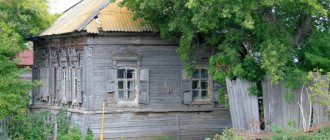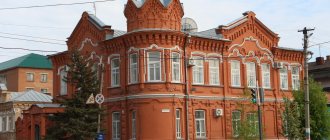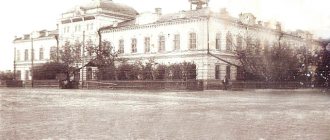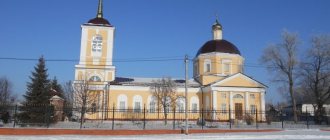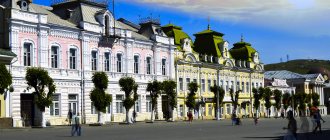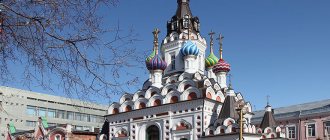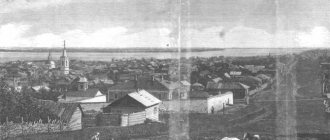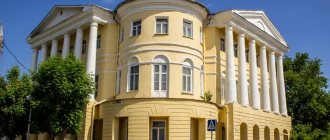You can see more about the districts of the Saratov region here.
The regional center Kalininsk is located in the far west of the Saratov region. It stands on the Balanda River, a tributary of the Medveditsa. It is separated from the regional center by 120 km, communication occurs by rail, and the Kalininsk-Saratovsky station is located here.
Also in the city there is a large junction of regional and federal (M6) highways leading to Balashov and Saratov. From the bus station, buses run to Saratov and to surrounding towns and villages.
About the city of Kalininsk
The history of Kalininsk dates back to the early stage of the development of the Saratov region by the Cossacks. When talking about the city, one cannot help but mention the name of the river on which it is located.
The emphasis in the word Balanda is placed on the last syllable, and it comes, as historians suggest, on behalf of the Cossack chieftain, who founded the first settlement here - a yurt.
It was first mentioned in scribe books in 1622, where it is indicated that beekeepers go to hunt from the Balandinsky yurt, collecting honey from wild bees. There is a second version, in the Vyatka dialect there is a verb “balandat”, meaning “to splash in the river”.
Balanda is a small river, predominantly snow-fed, and such a designation could have been applied to it in the old days.
For the first time in the chronicles, yurts appear during the time of Ivan the Terrible; it is mentioned that Turkic tribes lived here. Soon after, Cossacks settled on the forested banks of the river, and then peasant migrants from central Russia began to arrive, hoping to find fertile, uncultivated land here.
It is interesting that the Medveditsa River, whose tributary is the Balanda, is even mentioned in the materials of the negotiations on the annexation of Little Russia to Russia, held in 1652.
And in 1680, in those places where the Kharkov and Chernigov provinces were later created, Little Russian settlers arrived. Yurt turned into the village of Balanda. A little earlier than 1797, these lands were granted to Count Sheremetyev.
After the peasant reform was carried out, the village began to develop rapidly. By 1895, at the time of construction of the Bokovoy station, a branch of the Ryazan-Ural Railway, more than 10 thousand people lived here, peasants, merchants and townspeople, and up to 80 industrial and trading establishments operated. The parochial school began teaching children earlier, in 1878.
By the beginning of the twentieth century, 15,841 people already lived here. By this time, Balanda from the village became a volost. During that period, active construction was underway, 4 churches, a distillery of Count Sheremetyev, a gymnasium, and a vocational school appeared.
In 1903, the then Saratov governor Pyotr Arkadyevich Stolypin visited the settlement.
After the revolution, the development of Balanda continues. It was visited by M.I. Kalinin in 1919, and in 1939 it became a workers’ settlement.
A gutta-percha production plant and a motor transport enterprise are being built here. In 1962, the village became the city of Kalininsk, named after M.I. Kalinin.
Map
| Kalininsk: maps |
Kalininsk: photo from space (Google Maps) Kalininsk: photo from space (Microsoft Virtual Earth)
| Kalininsk. Nearest cities. Distances in km. on the map (in brackets along roads) + direction. Using the hyperlink in the distance , you can get the route (information courtesy of the AutoTransInfo website) | |||
| 1 | Bald Mountains | 25 (24) | IN |
| 2 | Atkarsk | 55 (111) | NE |
| 3 | Zhirnovsk | 60 (71) | YU |
| 4 | Ekaterinivka | 61 (62) | WITH |
| 5 | Samoilovka | 63 (75) | SW |
| 6 | Linevo (Volgograd region) | 72 (84) | YU |
| 7 | Rudnya (Volgograd region) | 77 (94) | YU |
| 8 | Tatishchevo | 79 (116) | IN |
| 9 | Elan (Volgograd region) | 80 (100) | SW |
| 10 | Light | 80 (120) | IN |
| 11 | Arkadak | 83 (120) | NW |
| 12 | Krasny Yar (Volgograd region) | 90 (110) | YU |
| 13 | Balashov | 91 (90) | Z |
| 14 | Sokolovy | 93 (113) | IN |
| 15 | Rtishchevo | 96 (115) | NW |
| 16 | Turks | 99 (147) | NW |
| 17 | Krasnoarmeysk | 100 (183) | SE |
| 18 | Prigorodnoye (Penza region) | 106 () | WITH |
| 19 | Saratov | 107 (103) | IN |
| 20 | Privolzhsky | 108 (131) | IN |
| 21 | Serdobsk | 109 (153) | WITH |
| 22 | Petrovsk | 109 (186) | NE |
| 23 | Malaya Serdoba (Penza region) | 112 () | WITH |
| 24 | Engels | 113 (118) | IN |
| 25 | Bekovo (Penza region) | 119 (154) | NW |
a brief description of
Located on the western edge of the Volga Upland, on the river. Balanda (tributary of the Medveditsa), 121 km west of Saratov. Railway station Kalininsk-Saratovsky. Road junction.
Territory (sq. km): 24
Information about the city of Kalininsk on the Russian Wikipedia site
Historical sketch
Founded in 1680 by immigrants from Ukraine as the village of Balanda. Name by river The gruel she was on. In 1897 - the settlement of Balanda.
Since 1939, the working village of Balanda. The city of Kalininsk since 1962, named after M.I. Kalinin (1875-1946).
Economy
Factories: rubber products, auto repair, asphalt concrete, brick. Food industry enterprises: dairy canning plant, poultry plant, brewery.
Main enterprises
RUBBER-ASBESTOS INDUSTRY
JSC "Kalinin Rubber Products Plant"
412450, Saratov region, Kalininsky district, Kalininsk, st.
50 Let Oktyabrya, 30 Offers:
foam rubber products, polymer-textile footwear, polyurethane products, paint and varnish products
Museums, galleries, exhibition halls
Kalinin Museum of History and Local Lore 412484, Saratov region, Kalinin district, Kalininsk, st. Sovetskaya, 20 Phone(s): (845 49) 2 11-66 Website: https://www.comk.ru/
| Population by year (thousands of inhabitants) | |||||||
| 1897 | 7.2 | 1996 | 20.0 | 2007 | 18.7 | 2015 | 16.0 |
| 1939 | 13.0 | 1998 | 20.1 | 2008 | 18.7 | 2016 | 15.9 |
| 1959 | 13.2 | 2000 | 20.1 | 2010 | 18.5 | 2017 | 15.8 |
| 1970 | 16.3 | 2001 | 20.1 | 2011 | 16.4 | 2018 | 15.8 |
| 1979 | 18.6 | 2003 | 18.9 | 2012 | 16.3 | 2019 | 15.6 |
| 1989 | 19.3 | 2005 | 18.9 | 2013 | 16.2 | 2020 | 15.5 |
| 1992 | 19.4 | 2006 | 18.8 | 2014 | 16.1 | 2021 | 15.2 |
Population of Kalininsk
As of 2018, just over 15 thousand people lived in Kalininsk . In 2000, the population reached 20 thousand, but the outflow of young people to large cities affected the dynamics of the growth of residents.
Now it ranks 764 out of 1113 cities in Russia. Previously, in 1939, the city was home to 60% Russians and 40% Ukrainians; now the national composition has become more homogeneous. A small Tatar community lives in Kalininsk.
The city has a chemical plant producing gutta-percha, previously evacuated from Ukraine in 1942, Rastkauchuk, a paint and varnish plant, a meat processing plant, and a cannery.
City dwellers also find work in agriculture. More than 20 agricultural enterprises and almost 200 peasant farms are actively operating in the region. You can purchase products at the collective farm market. More than 350 enterprises provide trade services to city residents.
The city in the old part is built up mainly with private brick houses, both Soviet and modern built. But in the new one you can see both panel multi-storey buildings and modern new buildings. There is a small road bridge across the river.
Kalininsk
(Saratov region)
OKATO code:
63221501
Founded:
1680
Urban settlement since:
1939
City since:
1962 City of district subordination (Kalininsky district, Saratov region)
Center:
Kalininsky district
The city was formerly called:
| Balanda | 1962 |
| Telephone code (reference phone) | |
| 84549***** | 25-2-22 |
Deviation from Moscow time, hours:
1
Geographic latitude:
51°30′
Geographic longitude:
44°29′
Altitude above sea level, meters:
150 Sunrise and sunset times in the city of Kalininsk
Education and culture of Kalininsk
General education schools, of which 24 have already been opened, and 19 kindergartens are responsible for education in the city. There is a technical school that trains personnel for agricultural production, and a branch of the Modern Humanitarian Academy has been opened.
The cultural development of children is ensured by art and music schools. You can play sports at the Start stadium; the children's and youth sports school teaches in several disciplines. Ski competitions in winter are held at Popova Shishka.
There is a city local history museum, where exhibitions will tell about the history of Balanda and the already established traditions of Kalininsk.
Earlier, in the 6th-7th centuries, Scythians, Sarmatians and Cimmerians lived near the Medveditsa River; some of the collections will allow us to learn more about their history. It is located on the first floor of an apartment building.
Cultural events, for example, tours of visiting celebrities, are organized at the Pobeda cinema.
Kalinin residents learn about the news from the newspaper “People's Tribune”, which has been published under different names since 1929. Its online version covers all significant events of the city and region.
Modern history
The area of modern Kalininsk (formerly Balanda) is 3.2 thousand square meters. km. The population of the city is 19.5 thousand people. Characterized by a significant proportion of the Ukrainian population (12.2%). The area is located in the steppe zone on the western spurs of the Volga Upland in the Medveditsa River basin, with soft natural features. The basis of the economic complex of the region is industry and agriculture. Main industrial enterprises: factories - rubber products, auto repair, milk and canning plant, poultry plant, brewery. The specialization of agriculture is grain and livestock farming with sunflower crops, as well as poultry farming. There are sports, art and 4 music schools. In Kalininsk there is the oldest agricultural mechanization school in the Saratov region, which trains general-purpose machine operators. The city of Kalininsk is a relatively young city. Its cleanliness and well-groomed appearance delight the eyes of visitors. [[Project Devotees and Famous/Sculptures of the city of Kalinisk, Saratov region|
Streets and sights of Kalininsk
The city, like many fortified places, was built from an elevated place on the river bank. It was called a town. Now it is the territory of the former Gorodok that has become the center of modern Kalininsk.
Among the most interesting sights of Kalininsk one could name the estate of Count Sheremetyev, but it is in complete desolation. Previously, it was a monument of history and landscape architecture, located on a high point in the city, “Popovaya Shishka”.
A park was laid out around the building with columns. Now only the servants' houses where the townspeople live are well preserved and are being renovated. There is also a recently built mosque in the city.
The wooden building is painted blue and decorated with carved wooden frames, which combine Eastern and Russian carving styles. The presence of three cemeteries – Russian, Ukrainian, Tatar – is also considered a unique attraction. Both Russians and Ukrainians strictly adhere to their cemeteries.
Now the monument to M.I. Kalinin has become the compositional center of the city. It is installed on the square where in the 1919 century the All-Union headman spoke to the Red Army soldiers.
From the point of view of interesting architectural objects, you need to examine the mansions of the merchants Gannenkov, which house the buildings of the Pension Fund, and the merchant Kuznetsov (the communications center is located here).
It is also necessary to examine the Church of St. Olga Equal to the Apostles. The colorful brick building with five blue domes attracts attention from afar. It was erected to replace the destroyed revolutionary field in 1990, from the bricks of the Sheremetyev estate.
The former Buldychenko teahouse located on the river bank, where the local administration is now located, will attract attention. In the old part you can see many merchant mansions, which formerly housed shops and taverns; almost all the buildings are in good condition.
The city center is very well maintained, there are many flower beds and flower beds. In summer you can relax on the equipped beach located on the river bank.
From the history of the village
The village of Balanda (now Kalininsk) was founded in 1680 by Ukrainians from the Chernigov and Kharkov provinces, on land that was granted by the tsarist government to Count Sheremetyev in the 18th century, and all the free peasants who settled here became serfs. Already at the beginning of the 18th century there were up to 500 households in the village. In 1913 there was a gymnasium in the village. Presumably one of the teachers there was Tatyana Zakharyevna Kalinina. The village was renamed in honor of M.I. Kalinin, who on July 20, 1919 spoke here at rallies in the railway depot and on the square in front of the Red Army soldiers of the 23rd Infantry Division of the 9th Army of the Southern Front and village residents. On the square where he performed, a monument to Kalinin was erected. Kalininsk received city status in 1962.
